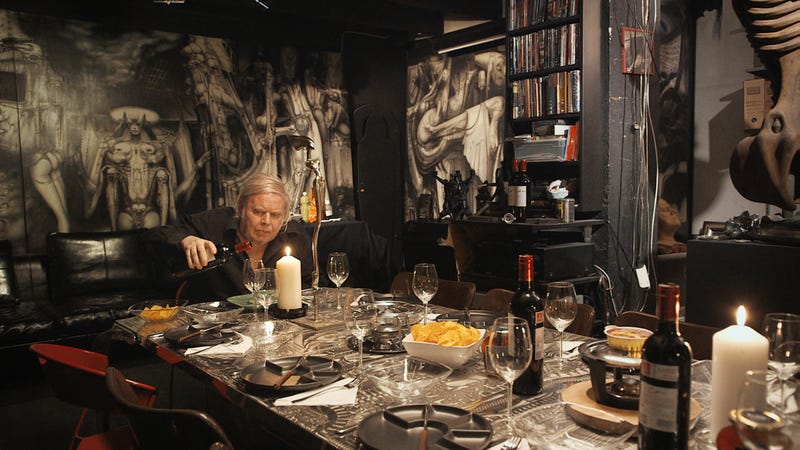Dark Star Offers A Melancholy, Intimate Portrait Of Artist H.R. Giger
By Cheryl Eddy

There’s a sadness running through Dark Star: H.R. Giger’s World — a portrait of the Swiss artist whose most famous creation was the title character in Alien. It comes from knowing that its subject died last year. But the mood suits this appreciative study of a man who counted fear and death among his muses.
Most of Belinda Sallin’s documentary, which opens May 15 (look for VOD August 18), takes place within and around Giger’s ramshackle Zurich home, a wondrous maze filled with his surreal drawings, paintings, sculptures, and other talismans: a skull collection, random things floating in jars, endless stacks of books, his always-underfoot pet cat, and, oh yeah, his Oscar. “The house is almost like a living being,” observes one close associate interviewed here, among several who offer articulate insight, including: his wife, Carmen; the poster seller who gave him his first break, Hans H. Junz; and one of his assistants, Thomas Gabriel Fisher, also known as Tom G. Warrior, frontman of death metal pioneers Celtic Frost.
As the film unfolds, a main topic of conversation is what Giger’s art — dark, disturbing, erotic, lushly sinister, filled with images of his signature “biomechanical” beings — represents (“certain dark areas that we all have related to the trauma of birth,” a psychiatrist friend speculates), and where it all came from. He was the product of parents who were well-off enough to own a retreat in the Swiss Alps (Giger later gave it to his first wife, with whom he remained friendly), but also apparently understanding enough to encourage their son’s unusual talent. When he was a child, his sister took him to a local museum to see an Egyptian mummy — which is indeed eerie, evidenced by its on-camera appearance — an encounter that scared him so much that he returned several weekends in a row, determined to overcome his fear. The mummy and its representation of death became key influences on his art, wife Carmen points out, also noting that “you have to come face to face with your dark side before you can see the light.”
This theme crops up again when the film turns to the suicide of Giger’s first longtime partner and frequent model, Li Tobler. Though he’s reticent throughout the rest of the film, Giger speaks openly about the pain of that loss. He turned to his art as a coping mechanism, and a few years later, Ridley Scott came calling. Alas, Scott is only seen here in archival on-set footage, but it’s great stuff, depicting a gleeful Giger’s claim that the studio told him his first design for the alien eggs “looked too much like a vagina.” (Also missing: Alejandro Jodorowsky or any mention of Giger’s work on the never-made Dune. For that, you’ll need to watch the Jodorowsky’s Dune documentary instead.)
Dark Star also addresses Giger’s odd position in the art world. It was only near the end of his life that the “serious” art scene welcomed him with museum exhibitions and the like; we see him traveling, in a worrisomely frail state, to a retrospective in Linz, Austria. Thanks to his Hollywood fame and his catalog of album-cover art, his art-world cred had become supplanted by his status as a pop-culture icon, inspiring musicians like Celtic Frost’s Fisher, as well as untold thousands of tattoos. The opening of the gorgeous H.R. Giger Museum, overseen by wife Carmen, brings out devoted fans who weep in his presence.
Mostly, though, Dark Star concentrates on delivering what its subtitle promises. There’s a certain amount of biography, but this is chiefly a doc about what it means to be a massively popular artist at the end of one’s life, too infirm to make art anymore— a process as important to existing as breathing. At this point, he’d rather stay home, puttering around his dark rooms and begrudgingly allowing his employees and family members to make some order out of the chaos of his belongings. In one spontaneous moment, an assistant reaches into a teetering pile and extracts a drawing dated 1960, an item of obviously great value. “There’s so much hidden away in this house that no one’s ever seen,” the young man says in amazement. We also see that same man stacking book after book in front of Giger as he autographs each one, a reminder that part of being a famous artist is embracing (or at least tolerating) its more businesslike aspects.
Unfortunately, what’s lacking in Dark Star is much input from the man himself — at heart, “just a normal guy,” according to his mother-in-law. Either because he physically can’t or would prefer not to speak much, Giger is the most-seen and the least heard figure in the film. Instead, his art does most of his talking. (It’s certainly evocative enough.) Giger’s death, which occurred just after the documentary wrapped, is handled sensitively, and suggests that he knew didn’t have much time left. His apparent contentment with that fact, and his satisfaction about the life he was lucky enough to live, offers unexpected uplift to the film’s final moments.
Images courtesy of Icarus Films.
No comments:
Post a Comment